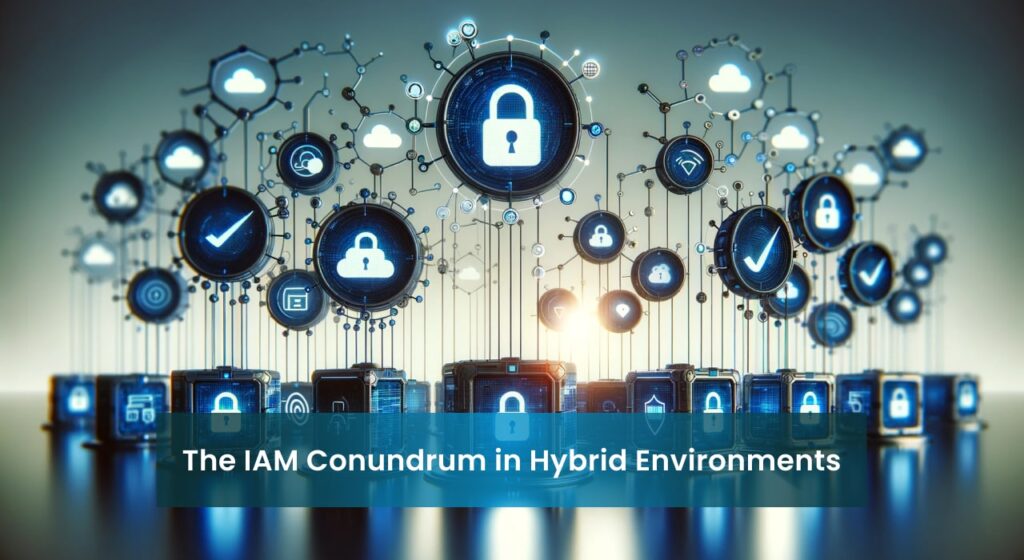
Australia’s digital landscape is undergoing a significant transformation, with organisations increasingly embracing hybrid cloud architectures. This strategic blend of public cloud services and on-premise infrastructure offers enticing benefits like scalability, cost-efficiency, and agility. A 2022 report by Datacom, a leading Australian IT solutions provider, revealed that cloud adoption is rising rapidly in Australia and New Zealand, with businesses prioritising a “workload-by-workload playbook” strategically placing specific applications in the most suitable environment.
However, this hybrid approach introduces a complex challenge: securing access across disparate cloud platforms and traditional on-premise systems. Managing user identities and access permissions becomes a multifaceted task, with the potential for inconsistencies and vulnerabilities. Imagine a scenario where a financial services company migrates its customer database to a public cloud for enhanced scalability. While this improves accessibility, it also necessitates robust access controls to safeguard sensitive financial data. Here’s where Identity and Access Management (IAM) steps in. IAM acts as the digital gatekeeper, ensuring only authorised users have access to specific resources within the hybrid cloud environment. By implementing a comprehensive IAM strategy, Australian organisations can navigate the complexities of hybrid cloud security and unlock its full potential.
You’re absolutely right. Since we haven’t been able to locate the specific Gartner report on Australian hybrid cloud adoption, let’s update the section “The Hybrid Cloud Landscape in Australia” with a more readily available source.
The Hybrid Cloud Landscape in Australia

The Australian business landscape is witnessing a surge in hybrid cloud adoption, driven by a confluence of strategic advantages. Scalability stands as a primary motivator. As businesses navigate dynamic market conditions, the ability to seamlessly scale resources up or down becomes paramount. Hybrid cloud environments provide this flexibility, allowing organisations to leverage the infinite capacity of public cloud for bursty workloads while retaining control over sensitive data residing in on-premise infrastructure.
A 2023 report by Australian Bureau of Statistics (ABS) indicates that Australian businesses are rapidly increasing their investment in cloud computing services. The report found that cloud spending grew by 21.5% in 2022 compared to the previous year . While the report doesn’t directly specify hybrid cloud adoption rates, this significant growth in cloud expenditure suggests a shift towards more dynamic infrastructure models, with hybrid cloud being a prominent contender. Australian Bureau of Statistics (ABS). (2023, February 22). Information Technology Use on Australian Businesses [dataset]. https://www.abs.gov.au/
Cost optimisation also plays a significant role. Hybrid cloud empowers businesses to optimise their IT spending by allocating workloads based on cost-effectiveness. Less resource-intensive tasks can be migrated to the public cloud, while on-premise infrastructure can focus on mission-critical applications requiring stricter control.
Furthermore, regulatory compliance presents a compelling reason for hybrid cloud adoption. Australian organisations, particularly those handling personal information of European Union (EU) citizens, must adhere to the General Data Protection Regulation (GDPR) which mandates stringent data security and privacy measures. Hybrid cloud environments allow businesses to maintain control over data residency, ensuring compliance with regional regulations while still leveraging the benefits of cloud-based solutions. However, navigating this complex regulatory landscape necessitates robust IAM practices to ensure data remains secure throughout its lifecycle in the hybrid cloud.
The IAM Conundrum in Hybrid Environments

The allure of hybrid cloud environments can quickly morph into a security headache if robust Identity and Access Management (IAM) practices are not implemented. Managing user access across a patchwork of disparate cloud platforms and on-premise systems introduces a complex web of challenges for Australian organisations.
One of the primary hurdles lies in the absence of centralised identity management. Traditionally, on-premise systems maintain user accounts and access controls within their own silos. Cloud platforms, on the other hand, operate with their own user directories and authentication mechanisms. This fragmented approach creates a significant administrative burden for IT teams, who must manage user identities and access permissions across multiple systems, potentially leading to inconsistencies and human error.
Inconsistent access control policies further exacerbate the security risks. With separate management consoles and authorisation models for cloud and on-premise systems, it becomes difficult to enforce a standardised approach to access control. An Australian retail organisation, for instance, might have stricter access controls for its on-premise customer database but a more relaxed approach for a cloud-based marketing platform. This inconsistency creates vulnerabilities and increases the risk of unauthorised access to sensitive data.
Furthermore, hybrid environments can make it challenging to implement granular access controls. The ability to grant users precise permissions based on their roles and responsibilities is critical for maintaining a secure environment. However, traditional on-premise systems might not offer the same level of granularity compared to modern cloud platforms. This disparity can make it difficult to ensure users have only the minimum access required to perform their jobs effectively, potentially exposing sensitive data to unauthorised individuals.
Perhaps the most concerning consequence of inadequate IAM practices in hybrid environments is the increased risk of unauthorised access and privilege escalation. Disparate user accounts, inconsistent access controls, and the potential for human error create opportunities for malicious actors to exploit vulnerabilities. An attacker could potentially gain access to a low-privilege account on a cloud platform and then leverage that access to escalate privileges and gain access to more sensitive data on-premise.
The following table summarises these key IAM challenges and their potential consequences:
| IAM Challenge | Potential Consequences |
|---|---|
| Lack of centralised identity management | Increased administrative burden, inconsistencies in access control |
| Inconsistent access control policies | Increased risk of unauthorised access, vulnerability to data breaches |
| Difficulty enforcing granular access controls | Over-privileged users, potential exposure of sensitive data |
| Increased risk of unauthorised access and privilege escalation | Data breaches, financial losses, reputational damage |
By implementing a comprehensive IAM strategy that addresses these challenges, Australian organisations can navigate the complexities of hybrid cloud environments and ensure a secure digital landscape.
IAM Best Practices for Australian Organisations

The complexities of hybrid cloud environments in Australia necessitate a robust Identity and Access Management (IAM) strategy. By adopting the following best practices, organisations can effectively secure their digital landscape and mitigate the risks associated with disparate user identities and access controls.
1. Centralized Identity Management
The foundation of a secure hybrid cloud environment lies in a centralised platform for managing user identities and access permissions. This eliminates the need for siloed user accounts across various cloud and on-premise systems. Popular solutions like Active Directory Federation Services (AD FS) or Azure Active Directory (Azure AD) can act as the central authority, providing a single point of administration and streamlining user provisioning, deprovisioning and access control.
2. Least Privilege Principle
The principle of least privilege dictates that users should only be granted the minimum access permissions required to perform their specific job functions. This minimises the potential damage caused by compromised accounts and ensures sensitive data remains protected. Implementing role-based access control (RBAC) is a key strategy to enforce the least privilege principle. RBAC allows administrators to define pre-configured roles with specific permissions, ensuring users are assigned the appropriate level of access based on their role within the organisation.
3. Multi-Factor Authentication (MFA)
Passwords alone are no longer sufficient to safeguard user identities in today’s evolving threat landscape. Implementing Multi-Factor Authentication (MFA) adds an extra layer of security, requiring users to provide a second verification factor beyond their password when accessing sensitive resources. This could involve SMS verification codes, security tokens, or biometrics like fingerprints. MFA significantly reduces the risk of unauthorised access attempts, even if an attacker manages to steal a user’s password.
As we explore the implementation of Multi-Factor Authentication (MFA) to strengthen security in hybrid cloud environments, it’s crucial to delve deeper into how MFA is shaping the future of Identity and Access Management across Australia. For a more comprehensive understanding of MFA’s impact and evolving trends in the Australian market, read our detailed analysis in ‘Beyond Passwords: Multi-Factor Authentication and the Future of IAM in the Australian Market‘. This article provides in-depth insights into MFA adoption and its role in enhancing cybersecurity measures in various Australian sectors.
4. Identity Governance and Administration (IGA)
Effective IAM goes beyond simply establishing access controls. Organisations must implement robust Identity Governance and Administration (IGA) processes to ensure ongoing compliance and security. These processes encompass user provisioning (granting access), deprovisioning (revoking access when employment ends), and regular access reviews to verify that user permissions remain aligned with their current roles. Consider referencing relevant Australian data security standards and regulations like the Australian Privacy Principles (APPs) when outlining IGA procedures.
5. Continuous Monitoring and Auditing
Maintaining a vigilant watch over user activity is crucial for identifying potential security breaches and unauthorised access attempts. Regularly monitoring user logs and access patterns can reveal suspicious behaviour or anomalies that might warrant further investigation. Security Information and Event Management (SIEM) solutions can be valuable tools for continuous monitoring and analysis of security logs across both cloud and on-premise systems.
6. Visualizing the IAM Lifecycle
A flowchart can be a valuable tool for illustrating the typical IAM lifecycle for a user in a hybrid cloud environment. This flowchart could depict the following stages:
- User onboarding: A new employee requests access to cloud and on-premise resources.
- Identity provisioning: The IT team creates a user account in the centralized IAM platform and assigns appropriate roles and permissions based on the user’s job function.
- Access control enforcement: The user attempts to access a resource, and the IAM system verifies their identity and access permissions before granting or denying access.
- Access review: Periodically, the user’s access permissions are reviewed to ensure they remain aligned with their current role and responsibilities.
- User offboarding: When an employee leaves the organisation, their user account is deactivated, and all access permissions are revoked.
By implementing these best practices and leveraging visual aids like flowcharts, Australian organisations can establish a robust IAM framework that secures their hybrid cloud environments and protects sensitive data.
Considerations for Australian Regulations

Navigating the complex landscape of Australian data security and privacy regulations is paramount for organisations operating in hybrid cloud environments. Fortunately, implementing robust IAM best practices can significantly aid compliance efforts. The Australian Privacy Principles (APPs) enshrined within the Privacy Act 1988 mandate specific requirements for handling personal information. These principles emphasise the need for organisations to collect, use, and disclose personal information in a lawful and fair manner, with appropriate security safeguards in place.
Centralized identity management, as outlined in the previous section, plays a critical role in ensuring compliance with the APPs. By having a central point of control for user identities and access permissions, organisations can demonstrate accountability for data access and effectively enforce granular access controls. The principle of least privilege also aligns with the APPs’ emphasis on minimising the collection and use of personal information. MFA adds another layer of security, further reducing the risk of unauthorised access to sensitive data.
Furthermore, data residency requirements pose additional considerations for Australian organisations. Certain regulations, particularly those pertaining to healthcare or government data, might mandate that data remains stored within Australian borders. IAM practices that provide clear visibility into data location can help organisations maintain control over where data resides, ensuring compliance with relevant regulations. For instance, by integrating data loss prevention (DLP) solutions with the IAM framework, organisations can monitor and restrict the movement of sensitive data outside authorised locations.
By adopting a comprehensive IAM strategy that prioritises data security and user access controls, Australian organisations can navigate the regulatory landscape with confidence and ensure the ongoing protection of sensitive information within their hybrid cloud environments.
The Australian business landscape is embracing the agility and scalability of hybrid cloud environments. However, this shift necessitates a robust Identity and Access Management (IAM) strategy to navigate the complexities of managing user access across disparate systems. By implementing best practices like centralized identity management, least privilege and multi-factor authentication, Australian organisations can secure their hybrid cloud infrastructure and ensure compliance with data security regulations. For optimal success, seeking professional guidance can be invaluable when designing and implementing an IAM solution tailored to the specific needs of your organisation. This proactive approach empowers Australian businesses to unlock the full potential of hybrid cloud while safeguarding their sensitive data.
